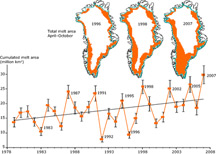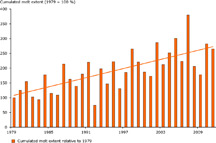Claim: Greenland is actually gaining
ice, not losing it as global warming alarmists would have you believe ``The
evidence so far suggests that the Greenland ice sheet is actually growing on
average" - Richard Lindzen, quoted here
Why this
claim is wrong: Cherry-picking, basically is the answer.
The cold high altitude interior of Greenland did have a net gain of snow
during the '90's, but this was found to be consistent with global warming
models, which include higher evaporation of warmer ocean water and deposition
as snow at the very high elevations of the top of the Greenland ice cap,
which was then still cold enough to have the net snow balance be
positive. However, the ERS-1 and ERS-2 satellite data used was not able
to say much about the behavior of ice near the coastal areas, where in
fact ice has been melting and sliding into the ocean at an accelerating
rate. And, since the most often used study which AGW-denialists use to
champion this myth was published over a decade ago, newer and better GRACE satellite data using gravity measurements show that the
entire continent is net losing ice at a rapidly accelerating rate (this YouTube shows how GRACE works). A recent paper by Wu et al. (2010) using a different calibration of GRACE
data, still finds Greenland is losing its icecap.
The graph at left shows the change in the total ice mass of Greenland, interior+coasts.
The regular up/down oscillations are due to seasonal summer melting vs winter
ice accumulation, not observational error. Note
that the rate at which the ice is disappearing has doubled during just this last
decade -
a decade during which the solar heating contribution has actually been dropping as
we've gone from a solar maximum in 2001 to an unusually deep solar minimum
in 2008/9. Ice loss rate is now seen to have redoubled again from 2009 to 2013. This trend is beyond exponential, and strongly suggests oversimplified old estimates of ice loss in a warming world need to be redone. Ice loss is also happening in Antarctica (and here).
A major factor is that the speed
of Greenland glaciers is rising rapidly. Meltwater on the surface is observed to follow channels down to the base of
the glacier, lubricating its gravity-induced motion towards the ocean. Without
detailed images of the base of glaciers, it was difficult to model this
with any confidence and so to be conservative, the IPCC
decided to not include this aspect in their AR4 report. Unfortunately,
the result is a significant under-appreciation of the loss of continental ice
at the poles due to global warming. To address this, Vermeer and Rahmstorff (2009) have devised a semi-analytic method which captures 98% of the variance in ice volume vs global temperatures, and use it to predict sea-level rises for the coming century using current and historical data. It shows sea-level rise of 3-6 feet by 2100 (depending on anthropogenic emission scenario), which is 3 times the IPCC AR4's conservative calculation (see 3rd panel graph below). Baffin Island, also in the Arctic and the
5th largest island on Earth, has lost
50% of its ice cap in the last 50 years. Globally, glaciers
worldwide are in rapid retreat (see graph below right - sorry for the poor
reproduction!). See this video of congressional testimony which contains a nice animation of the GRACE data on where and when ice is being gained and lost on Greenland. This 2011 paper in GRL shows excellent agreement between two ice volume measures: GRACE, and ice accumulation vs perimeter loss. They both show accelerating ice loss and strong rising sea level predictions for this century. However, a new paper published in Nature (Sundal et al. 2011) uses satellite measurements to show that once a critical level of melting is exceeded, the drainage under glaciers transitions to a more efficient mode and glacier speed slows. It will be interesting to see this new work included in future modelling of Greenland ice loss, as it is the major determiner of sealevel rise as global warming accelerates. Also contributing to Greenland and other polar ice loss is the darkening of surface ice. The darkening can be caused by partial melting of snow flakes, changing their geometry and reflectivity, and/or to the accumulation of dark pollutants and soot from the growing number of wildfires as climate warms. A short video on the albedo issue here.
A key point to make is that simplistic arguments I've heard from denialists about Greenland taking millenia to melt make the assumption that the ice stays in place. High altitude ice is certainly colder and more stable than low elevation ice, yet what we see is meltwater de-stabilizing the deep ice/continental interface and speeding the breakup and transport of ice to the oceans. This has been seen for many years now, described by polar scientists in this 2013 video (5 min). This study, published in Nature: Climate Change in 2012, shows indeed that Greenland is more sensitive to losing it's entire ice cap than previously thought. We are already close to the temperature levels which will completely melt Greenland over the next centuries, even if CO2 levels are brought back down. Hansen and Sato (2012) provide a good update on Greenland and Antarctic ice loss in a "business as usual" scenario into the future, and review the recent papers, arguing that simple linear extrapolations of past ice loss are a very likely underestimate of this non-linear process. While sea level rise by 2100 is still highly uncertain, the "scientific reticence" approach (Hansen and Sato 2012) of the IPCC 2007 AR4 should not be relied on for comfort, and sea level rise of over a meter or two are quite possible or even likely, given that past sea level rise was almost all due to thermal expansion (linear), while future rise will see a major additional contribution from continental glacier disintegrations..

Change in total Greenland
ice mass as determined from the GRACE data
|

Not only the total ice mass loss is increasing so is the size of the summer area that is experiencing that melt.
|
|

Global Glacier Thickness
Change: This shows average annual and cumulative glacier thickness change,
measured in vertical meters, for the period 1961 to 2005. Explosive
volcanic eruptions, which contribute aerosols to the stratosphere and cool
the Earth's climate, can temporarily raise glacier mass balance. Four
significant eruptions with worldwide impacts are shown on this graph
and are generally associated with periods of increased mass balance
due to lowered temperatures. Image courtesy of Mark Dyurgerov, Institute
of Arctic and Alpine Research, University of Colorado, Boulder. |

Global sea level rise over the coming century, from Vermeer and Rahmstorff (2009) is much higher vs the IPCC AR4 estimate which neglects the acceleration of ice sheets sliding into the ocean due to meltwater lubrication.
|
Another positive feedback not included in climate models is the darkening of Greenland and Arctic ice from increasing wildfires as increasing drought (also consistent with climate modelling) dries out Northern Hemisphere forests. Indeed, in 2012, wildfires were especially bad and studies show the resulting ash was able to briefly melt Greenland ice over the entire continent, even the normally permanently frozen highest elevation interior (Kaitlin et al. 2014 in PNAS).
Looking to the future, finds that even the northern ice cap of Greenland - thought to be safer from melt due to being colder - was in fact especially vulnerable, and melted during the last interglacial which exhibited temperatures as high as we'll see in the 21st Century. The reason seems to be melting due to warm water un-anchoring the ice-sheet's contact with topography in the shallow ocean there, removing the buttressing effect. (Born et al. 2012)
| In Short: It is spectacularly false. Greenland is losing ice at an sharply accelerating rate, as shown by the most reliable of data - the gravity-based GRACE satellite measurements. While there is more snow happening at the top of the Greenland high elevation plateau, due to increased water vapor in the warmer atmosphere, this increasing snowfall is dwarfed by rapidly melting and accelerating glaciers calving into the ocean around the coastlines. Multiple positive feedbacks are accelerating the process - dropping ice reflectivity due to wildfire ash and the geometry of melted snow crystals, loss of butressing of glaciers due to warming ocean/ice interface, acceleration of glaciers due to softening of the ice base where it contacts the underlying continent caused by moulins melting holes throughout the inland ice crevasses, and loss of contact between floating glacier ice terminus and the shallow base below. |
Return to Climate Denial Claims List
Return to Climate Science Main Page




